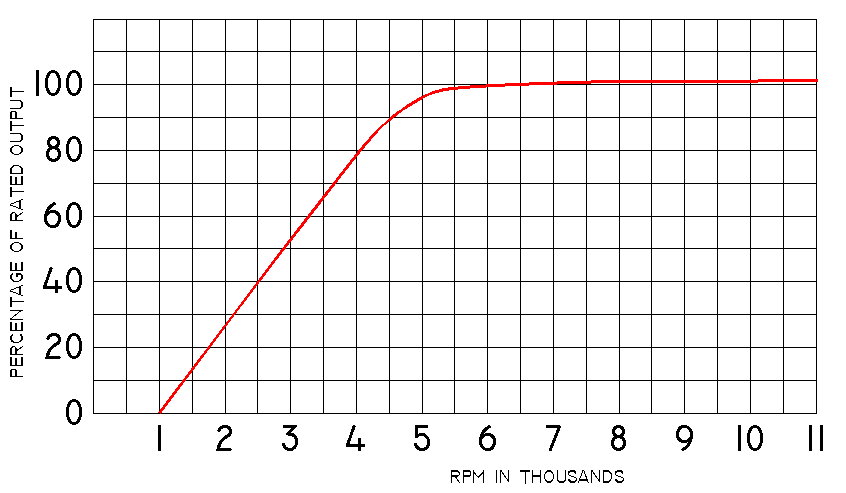Understanding Alternators . . . (continued)
Alternator Ouput versus Shaft Speed: We know that an alternator's
output is zero when the shaft is not turning. When does an alternator
begin to produce useful power? The above is an exemplar
alternator power output performance curve. Note that this alternator just
starts to deliver power at about 1000 RPM.
 Of course, an alternator begins to generate some voltage as soon as it starts
to rotate . . . but for our purposes, any voltage less than the regulation
setpoint value is not useful. This alternator just produces regulated output
at 1000 RPM . . . The available current is still zero. This is called "minimum
speed for regulation". At just above 1000 RPM, power available to
do work just begins. As speed increases, output increases until at about
5500 RPM, the curve stops rising. This happens at "minimum speed for full output".
Of course, an alternator begins to generate some voltage as soon as it starts
to rotate . . . but for our purposes, any voltage less than the regulation
setpoint value is not useful. This alternator just produces regulated output
at 1000 RPM . . . The available current is still zero. This is called "minimum
speed for regulation". At just above 1000 RPM, power available to
do work just begins. As speed increases, output increases until at about
5500 RPM, the curve stops rising. This happens at "minimum speed for full output".
Minimum Speed for Regulation: Let's assume that the bus is hot, the
alternator switch is ON, and alternator RPM is zero. The voltage regulator says
the bus voltage is too low and applies full bus voltage to the field but with
no result. No horsepower in; no watts out. Since the field winding has full bus
voltage applied, the under-speed alternator will behave just as if it had
a permanent magnet for a field. There is immediate potential for output
voltage developed in the alternator's stator windings as soon as the
alternator RPM increases from zero. However. until the regulator senses that
the voltage has reached regulation setpoint, the alternator will be fully
fielded and output voltage will be roughly proportional to RPM.
As soon as alternator speed is sufficient to produce regulator setpoint
output, the regulator will begin to reduce field voltage in response to
changes in RPM and/or load such that output voltage is constant at the regulator's
setpoint voltage. If you increase speed without adding load, the field voltage
gets lower and lower. At minimum speed for full output but with no load, the
field voltage on a 14v alternator may very well be LESS THAN one volt!
< < < < Back . . . . . . . . Next > > > >
 Of course, an alternator begins to generate some voltage as soon as it starts
to rotate . . . but for our purposes, any voltage less than the regulation
setpoint value is not useful. This alternator just produces regulated output
at 1000 RPM . . . The available current is still zero. This is called "minimum
speed for regulation". At just above 1000 RPM, power available to
do work just begins. As speed increases, output increases until at about
5500 RPM, the curve stops rising. This happens at "minimum speed for full output".
Of course, an alternator begins to generate some voltage as soon as it starts
to rotate . . . but for our purposes, any voltage less than the regulation
setpoint value is not useful. This alternator just produces regulated output
at 1000 RPM . . . The available current is still zero. This is called "minimum
speed for regulation". At just above 1000 RPM, power available to
do work just begins. As speed increases, output increases until at about
5500 RPM, the curve stops rising. This happens at "minimum speed for full output".